To effectively insulate your French doors, you've got several options. Start with weather stripping to seal gaps and reduce air leakage. Install door sweeps to block drafts at the bottom, and hang insulating curtains or drapes for an extra layer of protection. Consider upgrading to double-glazed glass or applying window film for improved thermal efficiency. Foam tape and caulking can seal smaller cracks, while storm doors offer additional insulation. For a seamless look, try magnetic insulation strips or custom-fit insulated panels. These methods not only keep your home cozy but can also greatly reduce your energy bills. Exploring these techniques further will reveal even more ways to maximize your French door's insulation.
Weather Stripping for French Doors
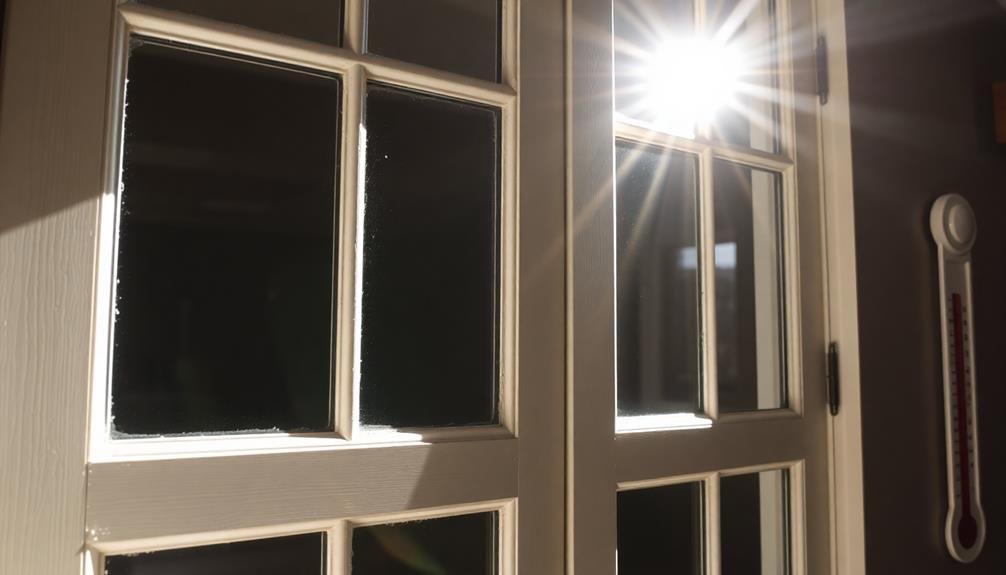
In light of their aesthetic appeal, French doors often come with a drawback: poor insulation. Weather stripping is an effective solution to this problem, helping to seal gaps and prevent air leakage. You'll find various types of weather stripping available for French doors, each with its own advantages.
Adhesive-backed foam tape is a popular and easy-to-install option. Simply cut it to size and stick it along the door frame and meeting edges. For a more durable solution, consider using V-strip weather stripping made of metal or vinyl. It's flexible and creates a tight seal when the door closes.
Brush-style weather stripping works well for the bottom of French doors, effectively blocking drafts and insects. Install a door sweep with a brush or vinyl flap for added protection.
For a more thorough approach, use tubular gasket weather stripping around the entire door frame. It provides excellent insulation and can withstand frequent use.
When installing weather stripping, guarantee a proper fit by measuring carefully and following manufacturer instructions. Regularly inspect and replace worn-out weather stripping to maintain its effectiveness and keep your French doors well-insulated year-round.
Door Sweep Installation
While weather stripping addresses gaps around the sides and top of French doors, the bottom edge often requires special attention. That's where door sweeps come in. You'll find these devices essential for blocking drafts, insects, and debris from sneaking under your French doors.
To install a door sweep, you'll need to measure the width of your door and choose an appropriate sweep. Most sweeps come in standard sizes, but you may need to trim them for a perfect fit. Here's a quick guide to different types of door sweeps:
| Type | Material | Pros | Cons |
|---|---|---|---|
| Brush | Nylon bristles | Flexible, durable | May allow small insects |
| Vinyl | PVC | Waterproof, easy to clean | Can wear down over time |
| Rubber | Natural or synthetic | Excellent seal | May drag on carpet |
| Automatic | Spring-loaded | Adjusts to floor | More expensive |
Once you've selected your sweep, attach it to the bottom of the door using screws or adhesive. Make sure it's level and just touches the threshold. For best results, combine a door sweep with weather stripping to create a complete seal around your French doors.
Insulating Curtains and Drapes
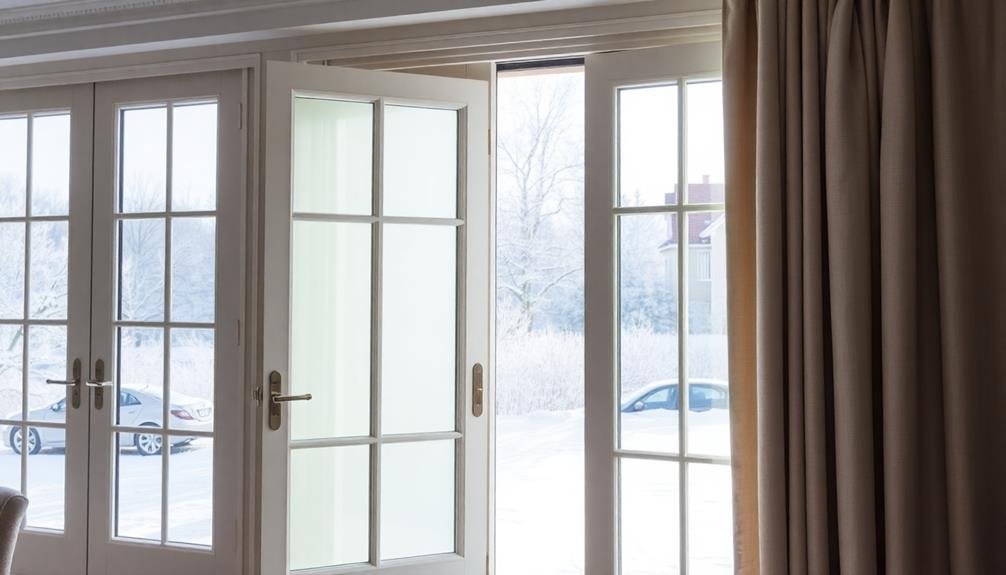
How can you enhance the insulation of your French doors beyond weather stripping and door sweeps? Consider adding insulating curtains or drapes to your French doors for an extra layer of protection against heat loss and drafts.
Choose thick, heavy fabrics like velvet, suede, or thermal-lined curtains for maximum insulation. Look for curtains with a high R-value, which indicates better insulating properties. Confirm the curtains extend beyond the door frame on all sides to create a tight seal when closed.
Install a ceiling-mounted curtain rod that's wide enough to allow the curtains to be pulled completely away from the doors when open. This will maximize natural light and views during the day while providing insulation at night or during extreme weather.
For even better insulation, consider using layered window treatments. Combine sheer curtains with heavier drapes or add cellular shades behind your curtains. This multi-layered approach traps air between the layers, creating additional insulation.
When hanging your curtains, position them as close to the French doors as possible to minimize air circulation between the curtains and the glass. Use magnetic or Velcro strips along the sides of the curtains to create a tighter seal against the door frame.
Double-Glazing Your French Doors
One of the most effective ways to improve your French doors' insulation is through double-glazing. This process involves replacing single-pane glass with two panes separated by a layer of air or gas. Double-glazing greatly reduces heat transfer, minimizing energy loss and improving your home's overall thermal efficiency.
When double-glazing your French doors, you'll need to choose between different gas fills. Argon is a popular option due to its affordability and insulating properties, while krypton offers superior performance but at a higher cost. The spacer between the panes also plays an essential role in insulation. Opt for warm-edge spacers made of materials like foam or plastic, as they conduct less heat than traditional aluminum spacers.
Consider low-emissivity (low-E) coatings for your double-glazed French doors. These microscopically thin metal layers reflect heat back into your home during winter and block solar heat gain in summer.
While double-glazing can be a considerable investment, it'll pay off through reduced energy bills and increased comfort. If you're not ready for a full replacement, you can explore retrofit double-glazing options that add a second pane to your existing doors.
Foam Tape Sealing Technique
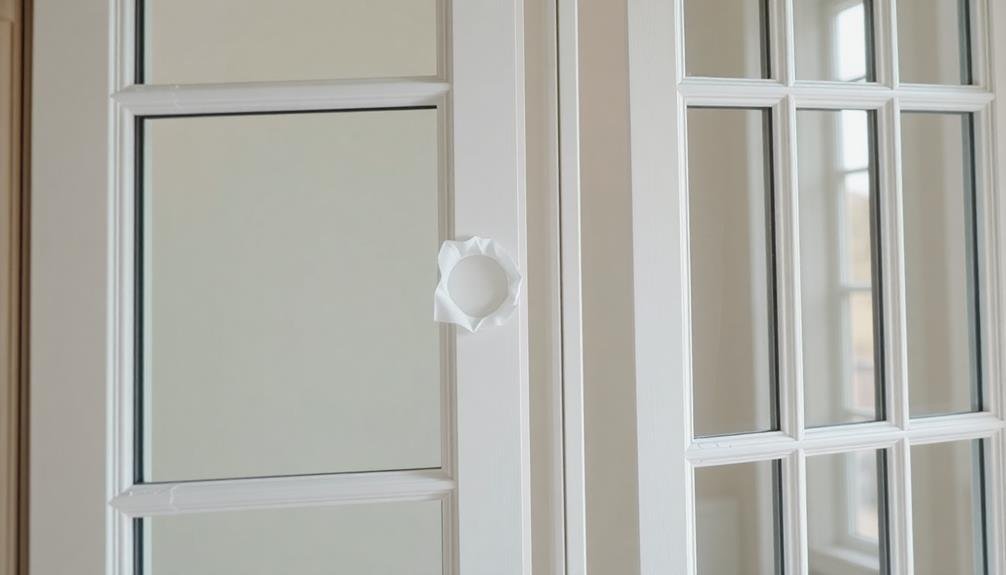
To effectively insulate your French doors using foam tape, you'll need to carefully apply it around the door frame and edges.
This method offers significant benefits, including improved energy efficiency and reduced drafts, making it a cost-effective solution for homeowners.
When selecting foam tape, consider factors such as thickness, adhesive strength, and weather resistance to guarantee peak performance for your specific door type and climate conditions.
Application Process
Applying foam tape to insulate your French doors is a straightforward process that you can complete in just a few steps.
Begin by cleaning the door frame thoroughly, removing any dirt, dust, or old adhesive residue. This guarantees the foam tape will adhere properly.
Measure the lengths of the door frame where you'll apply the tape, then cut the foam tape to size. It's better to cut slightly longer pieces and trim them later if necessary.
Peel off the backing from one side of the tape and carefully apply it to the clean door frame, starting at one corner and working your way around.
Press the tape firmly into place, ensuring there are no gaps or bubbles. Pay special attention to the corners, where air leaks are most likely to occur.
If you're using self-adhesive foam tape, you're done once you've applied it to the entire frame. For non-adhesive varieties, you'll need to use a strong adhesive to secure the tape.
Benefits and Effectiveness
The effectiveness of foam tape as a French door insulation method is undeniable. You'll notice immediate benefits once you've applied this simple yet powerful solution. Foam tape creates a tight seal between the door and frame, greatly reducing air leakage and improving your home's energy efficiency.
By using foam tape, you'll experience:
- Lower energy bills due to reduced heating and cooling costs
- Increased comfort with fewer drafts and temperature fluctuations
- Improved soundproofing, minimizing outside noise
- Enhanced protection against moisture and pests
The foam tape's compression properties allow it to conform to uneven surfaces, ensuring a consistent seal even as your doors settle or shift over time. You'll find that this method is particularly effective for French doors with gaps of up to 3/8 inch.
For larger gaps, you may need to combine foam tape with other insulation techniques for the best results.
While foam tape is highly effective, it's essential to recognize that its lifespan can vary depending on usage and environmental factors. You should inspect the tape annually and replace it as needed to maintain its insulation benefits.
With proper application and maintenance, foam tape can greatly improve your French doors' energy efficiency for years to come.
Choosing the Right Tape
When selecting foam tape for your French door insulation project, you'll need to contemplate several key factors. First, consider the tape's thickness. Thicker tapes generally provide better insulation but may interfere with door closure if too thick. Aim for a tape between 1/8 to 1/4 inch thick for ideal results.
Next, examine the tape's density. Higher density foam offers superior insulation and durability. Look for closed-cell foam tapes, as they resist moisture and last longer than open-cell alternatives. Additionally, make certain the tape's adhesive is strong enough to withstand frequent door use and varying temperatures.
Consider the tape's width as well. It should be wide enough to cover the gap between the door and frame but not so wide that it's visible when the door is closed. Typically, a width of 1/2 to 3/4 inch works well for most French doors.
Lastly, choose a tape color that matches your door frame to maintain a seamless appearance. While white is common, you can find foam tapes in various colors to suit your needs.
Cellular Shades for Insulation
Cellular shades stand out as one of the most effective insulation solutions for French doors. These versatile window treatments feature a honeycomb-like structure that traps air, creating an excellent barrier against heat transfer. You'll find cellular shades in various cell sizes, with larger cells providing better insulation.
When choosing cellular shades for your French doors, consider the following benefits:
- Energy efficiency: They can reduce heat loss by up to 40%
- Light control: Options range from sheer to room-darkening
- Noise reduction: The cellular structure helps dampen outside sounds
- Customizable fit: Available in various sizes and mounting styles
To maximize insulation, opt for double-cell shades with a larger cell size. These offer superior thermal performance compared to single-cell options. You can install cellular shades directly on the door frame or use a tension rod for a less permanent solution.
For ideal coverage, choose shades that extend slightly beyond the glass area of your French doors.
Remember to open and close your cellular shades based on the time of day and season to make the most of their insulating properties. During winter, keep them closed at night to retain heat, and open them during sunny days to let warmth in.
Draft Snakes and Door Blockers
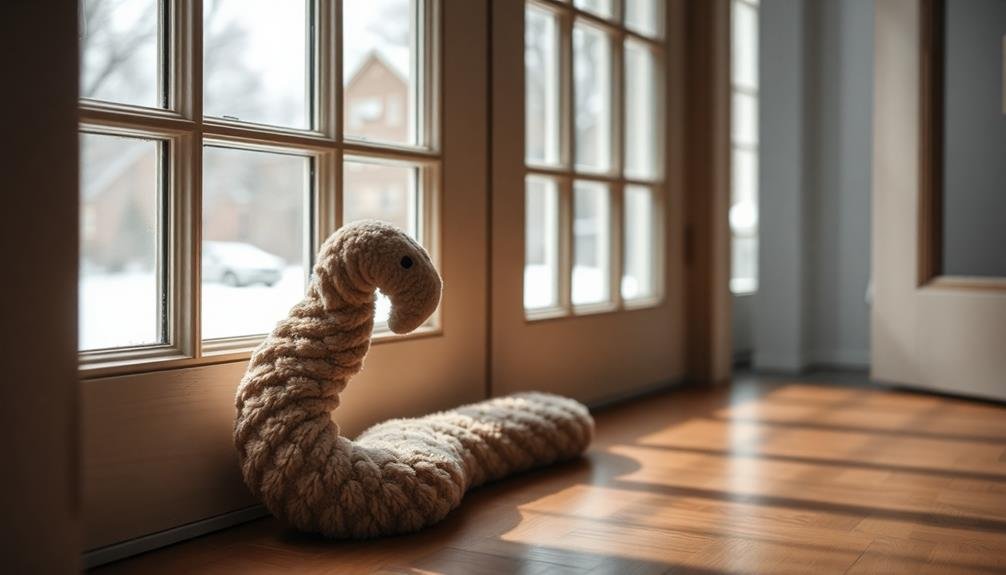
Draft snakes and door blockers offer a simple, cost-effective solution for insulating your French doors.
You'll find these in various materials, including fabric-covered foam tubes, weighted fabric pouches, and rigid plastic or metal door sweeps.
To maximize their effectiveness, place draft snakes snugly against the bottom of your French doors, and consider installing door sweeps on the interior side for a more permanent solution.
Types and Materials
Choosing the right draft snake or door blocker can make a significant difference in insulating your French doors. These simple devices come in various types and materials, each offering unique benefits for your home's energy efficiency.
Fabric draft snakes are popular due to their versatility and aesthetic appeal. You'll find them filled with materials like:
- Sand or small pebbles for weight
- Polyester fiberfill for a softer feel
- Rice or beans for a moldable texture
- Foam beads for lightweight insulation
For a more structured option, consider rigid foam door blockers. These are typically made from closed-cell foam, which provides excellent insulation and durability. They're often covered with a fabric sleeve for a more attractive appearance.
If you're looking for a quick, temporary solution, inflatable door blockers are an excellent choice. They're easy to install and remove, making them ideal for renters or seasonal use.
For a long-term fix, you might opt for a door sweep. These attach to the bottom of your French doors and create a tight seal against the threshold. They're typically made of rubber, silicone, or brush-like materials, offering both insulation and protection against drafts.
Placement and Installation Tips
Proper placement and installation of draft snakes and door blockers are essential for maximizing their effectiveness. For draft snakes, position them snugly along the bottom of your French doors, guaranteeing they cover the entire width. If you're using a double-sided draft snake, place it between the doors when closed. For added insulation, consider using draft snakes on both the interior and exterior sides of the doors.
When installing door blockers, focus on the areas where drafts are most likely to occur. Place them along the sides and top of the door frame, as well as between the doors if they're double French doors. Use adhesive-backed weatherstripping for a more permanent solution, or opt for removable foam tape if you prefer flexibility.
For the best results, combine different insulation methods. Use draft snakes at the bottom and door blockers on the sides and top. Don't forget to address any gaps around the door frame with caulk or expanding foam.
Remember to measure your doors accurately before purchasing insulation materials to guarantee a proper fit. By carefully placing and installing these insulation tools, you'll greatly reduce heat loss and improve your French doors' energy efficiency.
Window Film Application
In addition to weatherstripping and curtains, window film provides an effective barrier against heat loss through French doors. This thin, transparent material adheres directly to the glass, creating an extra layer of insulation.
You'll find various types of window film available, each offering different levels of insulation and privacy.
To apply window film to your French doors:
- Clean the glass thoroughly, removing any dirt or residue
- Measure and cut the film to fit each pane, leaving a small margin
- Spray the glass with a soapy solution to help position the film
- Carefully apply the film, smoothing out air bubbles as you go
Once applied, the film is nearly invisible and won't interfere with the appearance of your French doors. It's an excellent option for renters or those who don't want to make permanent changes to their doors.
Window film can reduce heat loss by up to 30%, helping to lower your energy bills. It also blocks harmful UV rays, protecting your furniture and flooring from sun damage.
While not as effective as double-glazing, window film is a cost-effective and easy-to-implement solution for improving your French doors' insulation.
Caulking Gaps and Cracks
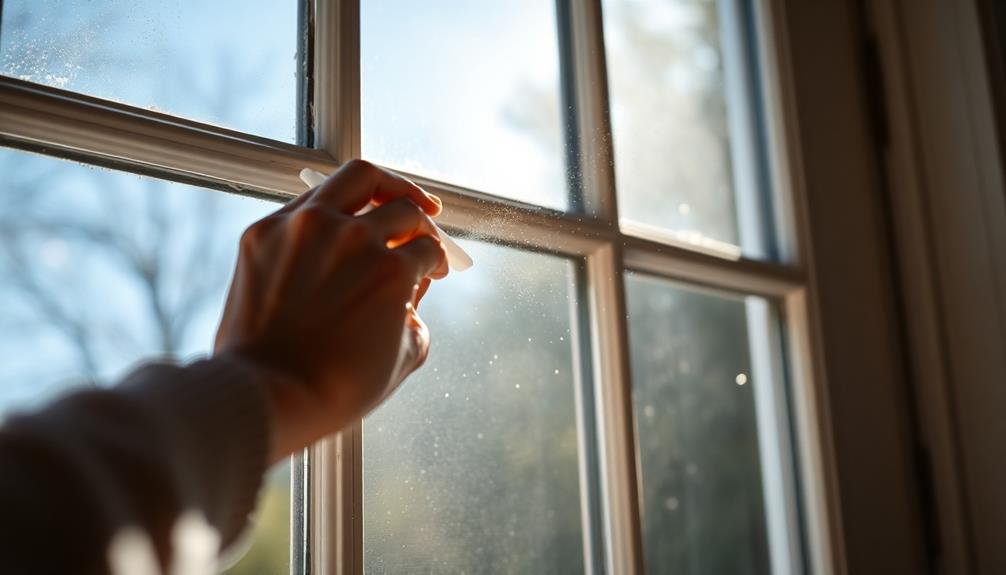
While window film addresses heat loss through the glass, it's equally important to tackle air leaks around your French doors. Caulking gaps and cracks is an effective way to seal these air leaks and improve your door's insulation.
Start by inspecting the entire perimeter of your French doors, including the frame and weatherstripping, for any visible gaps or cracks.
Choose a high-quality, weatherproof caulk that's suitable for your door's material. Clean the area thoroughly and make certain it's completely dry before applying the caulk.
Use a caulking gun to apply a continuous bead along the gaps, smoothing it with a wet finger or caulk tool for a neat finish. Pay special attention to the corners and joints where different materials meet, as these areas are prone to air leaks.
Don't forget to caulk around the door frame where it meets the wall, both inside and outside. For larger gaps, you may need to use foam backer rods before applying caulk.
Allow the caulk to dry completely before painting or exposing it to moisture. Regularly inspect and maintain the caulking to guarantee its effectiveness over time.
Storm Doors for Added Protection
Installing storm doors can greatly enhance your French doors' insulation.
You'll find various types of storm doors available, including full-view, retractable screen, and ventilating options.
To guarantee peak performance, it's essential to properly install and maintain your storm doors, which includes regular cleaning, lubricating moving parts, and checking weatherstripping.
Types of Storm Doors
Storm doors frequently serve as an excellent addition to French doors, offering an extra layer of insulation and protection.
When choosing a storm door for your French doors, you'll encounter several types, each with its own benefits:
- Full-view storm doors: These feature a large glass panel that spans nearly the entire door, allowing maximum visibility and light. They're ideal for showcasing your French doors while providing insulation.
- Ventilating storm doors: These come with retractable screens that can replace the glass panels, allowing for airflow when desired. They're perfect for enjoying fresh air without compromising security.
- Mid-view storm doors: These have a smaller glass panel in the upper portion and a solid panel at the bottom. They offer a balance between visibility and privacy.
- Security storm doors: These are built with reinforced frames and heavy-duty locks, prioritizing safety over aesthetics.
When selecting a storm door, consider factors such as your climate, desired level of visibility, and security needs.
You'll also want to guarantee the door's style complements your French doors and overall home aesthetic.
Installation and Maintenance
Once you've selected the ideal storm door for your French doors, proper installation and regular maintenance are key to maximizing its effectiveness.
To install your storm door, carefully follow the manufacturer's instructions, guaranteeing a tight seal around the frame. Use weatherstripping to fill any gaps and prevent drafts. If you're not confident in your DIY skills, consider hiring a professional for installation.
Maintain your storm door by regularly cleaning it with mild soap and water. Inspect the weatherstripping and seals annually, replacing them if they're worn or damaged. Lubricate hinges and moving parts to guarantee smooth operation. Check for any loose screws or hardware and tighten them as needed.
During winter, remove the screen insert and replace it with a glass panel for better insulation. In summer, swap back to the screen for improved ventilation. Keep the door's sweep clean and adjusted to maintain a proper seal with the threshold.
If you notice condensation between the storm door and French door, improve ventilation by slightly opening the storm door or installing air vents.
Magnetic Insulation Strips
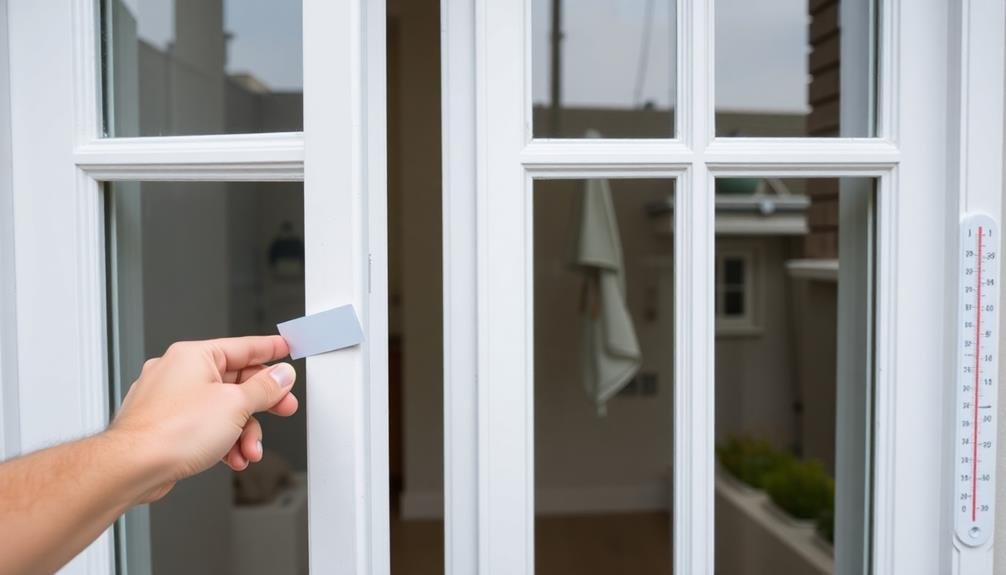
In recent years, magnetic insulation strips have emerged as a popular and effective solution for sealing French doors. These innovative strips use magnetic force to create a tight seal between the door and frame, considerably reducing air leakage and improving energy efficiency.
You'll find them easy to install and maintain, making them an attractive option for homeowners looking to enhance their French doors' insulation.
To get the most out of magnetic insulation strips, consider the following benefits:
- Seamless integration with your existing door design
- Adjustable tension for a custom fit
- Weather-resistant materials for long-lasting performance
- Easy removal for cleaning or replacement
When installing magnetic insulation strips, verify you measure your doors accurately to achieve the best fit. Clean the surface thoroughly before applying the adhesive backing, and press firmly along the entire length to secure the strip in place.
You'll notice an immediate difference in draft reduction and noise insulation once properly installed.
For maximum performance, regularly inspect your magnetic insulation strips for signs of wear or damage. Clean them periodically with a damp cloth to remove dust and debris, verifying the magnetic seal remains strong and effective.
With proper care, these strips can provide years of reliable insulation for your French doors.
Insulated French Door Panels
Many homeowners are turning to insulated French door panels as a robust solution for enhancing energy efficiency. These panels are designed to fit snugly within the door frame, creating an additional barrier against heat transfer.
You'll find they're particularly effective during extreme weather conditions, helping to maintain a comfortable indoor temperature year-round.
To install insulated panels, you'll need to measure your French doors accurately. Custom-fit panels are available, ensuring a perfect seal. They're typically made of materials like foam core or reflective insulation, covered with a decorative fabric to match your décor.
You can easily attach them using hooks, magnets, or Velcro strips.
One of the main advantages of insulated panels is their versatility. You can remove them when not needed, allowing you to enjoy the full view through your French doors.
They're also an excellent option for renters, as they don't require permanent modifications to the doors.
When choosing insulated panels, consider factors like R-value, ease of installation, and aesthetic appeal. Higher R-values indicate better insulation properties.
Look for panels with weatherstripping around the edges for ideal sealing.
Frequently Asked Questions
Can French Doors Be as Energy-Efficient as Regular Exterior Doors?
Yes, French doors can be as energy-efficient as regular exterior doors. You'll need to guarantee they're properly installed, weatherstripped, and have high-quality double or triple-pane glass. Adding insulating curtains or cellular shades can further boost their efficiency.
How Often Should Insulation Methods for French Doors Be Replaced or Maintained?
You'll need to maintain your French door insulation annually. Check weatherstripping and seals every year, replacing them if worn. Reapply caulk as needed. For more extensive insulation methods, like curtains or films, replace every 3-5 years for peak performance.
Are There Smart Home Devices Specifically Designed for Insulating French Doors?
You'll find smart devices designed for insulating French doors. Automated curtains, smart weather stripping, and Wi-Fi-enabled draft detectors can help. You can also install smart thermostats to monitor temperature differences and adjust heating accordingly near your doors.
What's the Average Cost Difference Between DIY and Professional French Door Insulation?
You'll typically save 50-70% by insulating French doors yourself. DIY kits cost $50-$150, while professional installation ranges from $200-$500. However, the exact difference depends on your door size and chosen materials.
Can Insulating French Doors Affect Their Operation or Warranty?
Yes, insulating your French doors can impact their operation and warranty. You'll need to be careful not to interfere with hinges or locking mechanisms. It's best to check your warranty terms before making any modifications to avoid voiding coverage.
In Summary
You've now got a range of effective methods to insulate your French doors. From weather stripping to magnetic strips, you're equipped to tackle drafts and energy loss. Don't forget to combine techniques for the best results. Whether you're sealing gaps, adding curtains, or installing storm doors, you'll soon enjoy a more comfortable and energy-efficient home. Take action today, and you'll feel the difference in both comfort and utility bills.

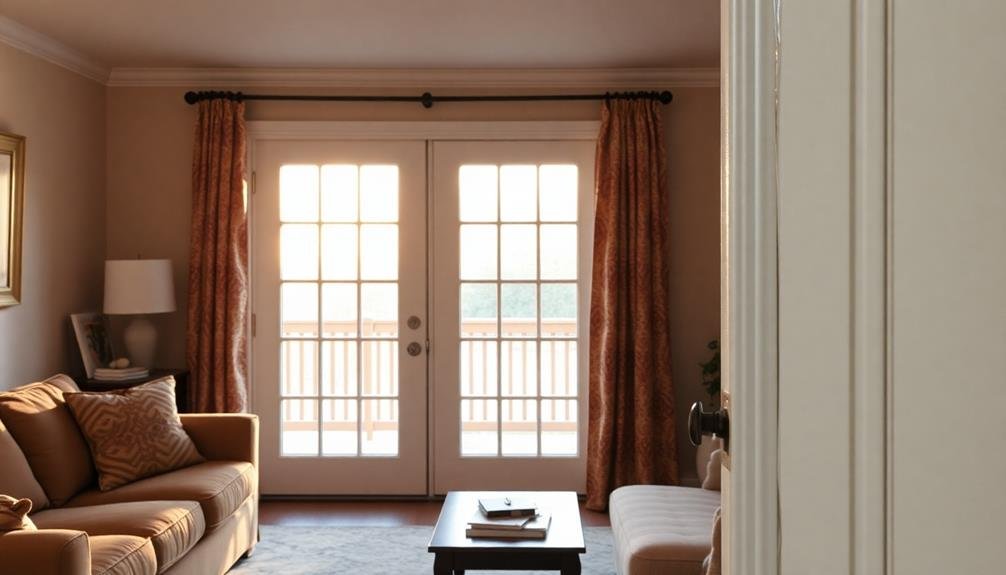



Leave a Reply